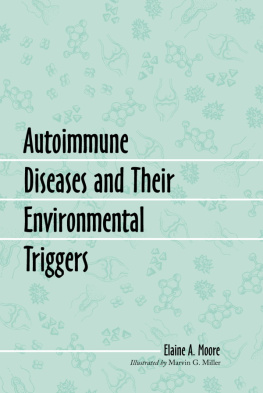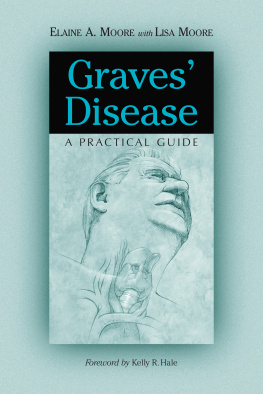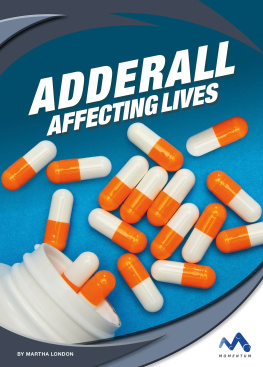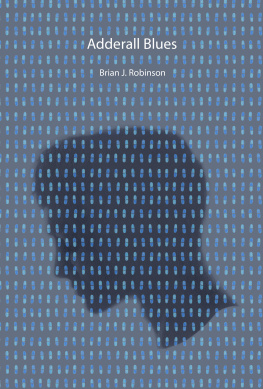
Table of Contents
McFarland Health Topics
Living with Multiple Chemical Sensitivity: Narratives of Coping.
Gail McCormick. 2001
Graves Disease: A Practical Guide.
Elaine A. Moore with Lisa Moore. 2001
Autoimmune Diseases and Their Environmental Triggers.
Elaine A. Moore. 2002
Hepatitis: Causes, Treatments and Resources.
Elaine A. Moore. 2006
Arthritis: A Patients Guide.
Sharon E. Hohler. 2008
The Promise of Low Dose Naltrexone Therapy: Potential Benefits in Cancer, Autoimmune, Neurological and Infectious Disorders.
Elaine A. Moore and Samantha Wilkinson. 2009
Living with HIV: A Patients Guide.
Mark Cichocki, RN. 2009
Understanding Multiple Chemical Sensitivity: Causes, Effects, Personal Experiences and Resources.
Els Valkenburg. 2010
Type 2 Diabetes: Social and Scientific Origins, Medical Complications and Implications for Patients and Others.
Andrew Kagan, M.D. 2010
The Amphetamine Debate: The Use of Adderall, Ritalin and Related Drugs for Behavior Modification, Neuroenhancement and Anti-Aging Purposes.
Elaine A. Moore. 2011
Also by Elaine A. Moore
Encyclopedia of Sexually Transmitted Diseases
(McFarand, 2005; paperback 2009)
Encyclopedia of Alzheimers Disease; With Directories of Research, Treatment and Care Facilities
(McFarland, 2003)
Library of Congress Cataloguing-in-Publication Data
Moore, Elaine A., 1948
The amphetamine debate : the use of Adderall, Ritalin and related drugs for behavior modification, neuroenhancement and anti-aging purposes / Elaine A. Moore ; foreword by K. Scott Pacer
p. cm. (McFarland health topics)
Includes bibliographical references and index.
ISBN 978-0-7864-5873-8
1. Amphetamines. 2. Methylphenidate. 3. Central
nervous system stimulants. 4. Attention-deficit hyperactivity disorderChemotherapy.
[DNLM: 1. Amphetaminestherapeutic use. 2. Amphetamine-Related Disorderspsychology. 3. Amphetaminesadverse effects. 4. Attention Deficit Disorder with Hyperactivitydrug therapy. 5. Methylphenidatetherapeutic use. QV 102]
RC568.A45M66 2011
362.29'9dc22 2010038425
British Library cataloguing data are available
2011 Elaine A. Moore. All rights reserved
No part of this book may be reproduced or transmitted in any form or by any means, electronic or mechanical, including photocopying or recording, or by any information storage and retrieval system, without permission in writing from the publisher.
Front cover image 2011 Shutterstock
McFarland & Company, Inc., Publishers
Box 611, Jefferson, North Carolina 28640
www.mcfarlandpub.com
To my husband Rick for his constant patience, encouragement and support. Who else would hook up the generator in our camper so I could have a place nearby to write whenever the winter snowstorms or spring winds knocked down our power lines?
This book is not intended as a substitute for medical treatment. It is intended for the education and empowerment of those in need of information on amphetamines and related drugs used in the treatment of behavioral disorders, neuroenhancement and antiaging. Patients interested in using the therapies described in this book should consult their personal physicians.
Acknowledgments
I have many people to thank for making this book possible. Id especially like to take this opportunity to thank my good friend Dr. Judy Canfield for reviewing chapters, proofreading, assisting with research and offering suggestions for improvement. Special thanks also go to John Peters for reviewing early drafts and offering insightful critiques. Im also grateful to my colleague, the clinical chemist Marv Miller, for his clever illustrations that help lighten up the technical sections. In addition, Id like to express my gratitude to Dr. David Sulzer from Columbia University for graciously sending me reprints and for Dr. Nicholas Rasmussen for his guidance. Thanks are also due to Dr. Scott Pacer for steering me in the right direction and answering my many questions regarding the treatment of attention deficit hyperactivity disorder (ADHD). Im also grateful to my friends, friends of friends, and acquaintances who willingly shared their personal experiences and the experiences of their children using amphetamines and related psychostimulants as cognitive enhancers or as treatments for ADHD. Although their stories shall remain anonymous, they know who they are and I appreciate their honest evaluations. Last but not least I must thank my family for their unconditional support.
Foreword by K. Scott Pacer, M.D.
Effective treatments for attention deficit hyperactivity disorder (ADHD) have evolved over the last few decades as our understanding of neurochemistry has improved. In addition, subtypes of ADHD, as well as the frequent coexistence of comorbid conditions, are now recognized. Comorbidities are very common in individuals with ADHD, and the effective treatment of ADHD is truly a biopsychosocial model. This means that although stimulant medications or ADHD have brought about rapid improvement in symptom control, behavioral and social treatments are also important in helping improve functioning in the home, school and in daily interactions with peers. A thorough evaluation for ADHD needs to be comprehensive and must include an evaluation for comorbities. When comorbidities are found, they must also be treated because comorbities increase impairment and complicate ADHD treatment.
Some of the comorbities associated with ADHD are oppositional defiant disorder (ODD), conduct disorder, major depressive disorder, anxiety disorder, bipolar disorder and tic disorders. Any patient with mood or anxiety symptoms need to be evaluated for a possible comorbidity. In evaluating individuals with behavioral disorders, its important to determine if specific symptoms are primary or secondary to ADHD. For instance, is the child or adult who is depressed or anxious exhibiting symptoms due to ADHD affecting their lives or are they expressing symptoms of a true comorbidity?
Mood and anxiety symptoms when they co-exist with ADHD need to be treated first as treatment with stimulant medications can often exacerbate these conditions. Medical disorders such as absence seizures or sleep disorders or environmental issues such as abuse or family adversity also need to be ruled out as the cause of inattention or behavioral problems. Once these are fully evaluated and treated, then there should be a revaluation for ADHD symptoms to evaluate the benefits of treatment for an individual in more than one setting. This is the art of treating ADHD.
Once ADHD is established, treatment is based on the use of either stimulant or nonstimulant medications. Each type of medication can have both benefits and risks. For optimal results, the specific therapy needs to be tailored to the individual. One factor in assessing benefits is the specific drugs onset and duration of action, that is whether the drug is short or long-acting. The reasons for one drug over another depend on an individuals symptoms. For instance, when there are concerns over an increase in tics, a nonstimulant may be beneficial but it may take a couple of weeks for effects to be seen.
Alternately, there may be a need to improve symptom control immediately to prevent an individual from failing academically or losing their job due to inattention. Each and every ADHD medication can have a place, and discussing the specific needs of the individual is important for improving optional functioning.
Next page













